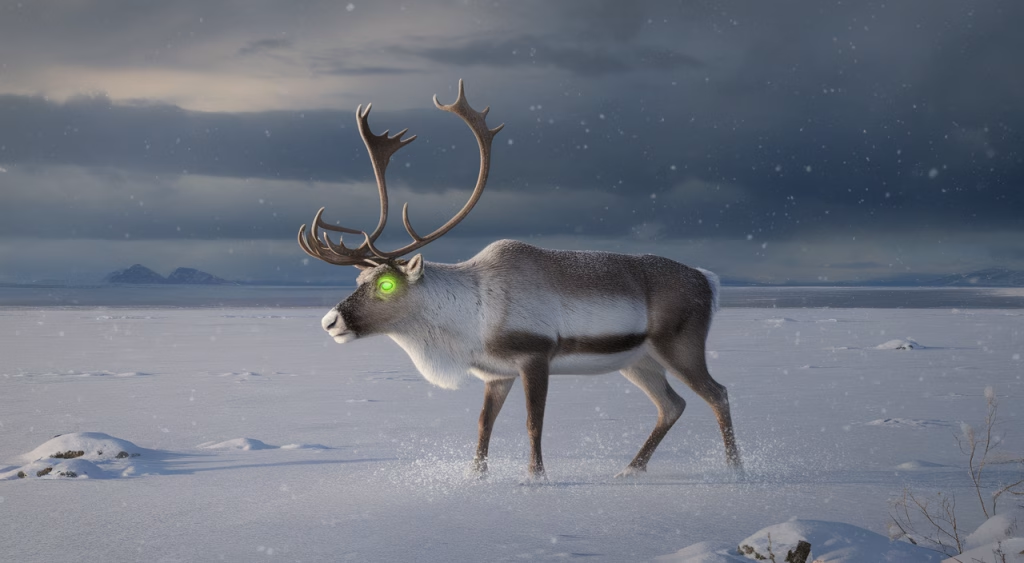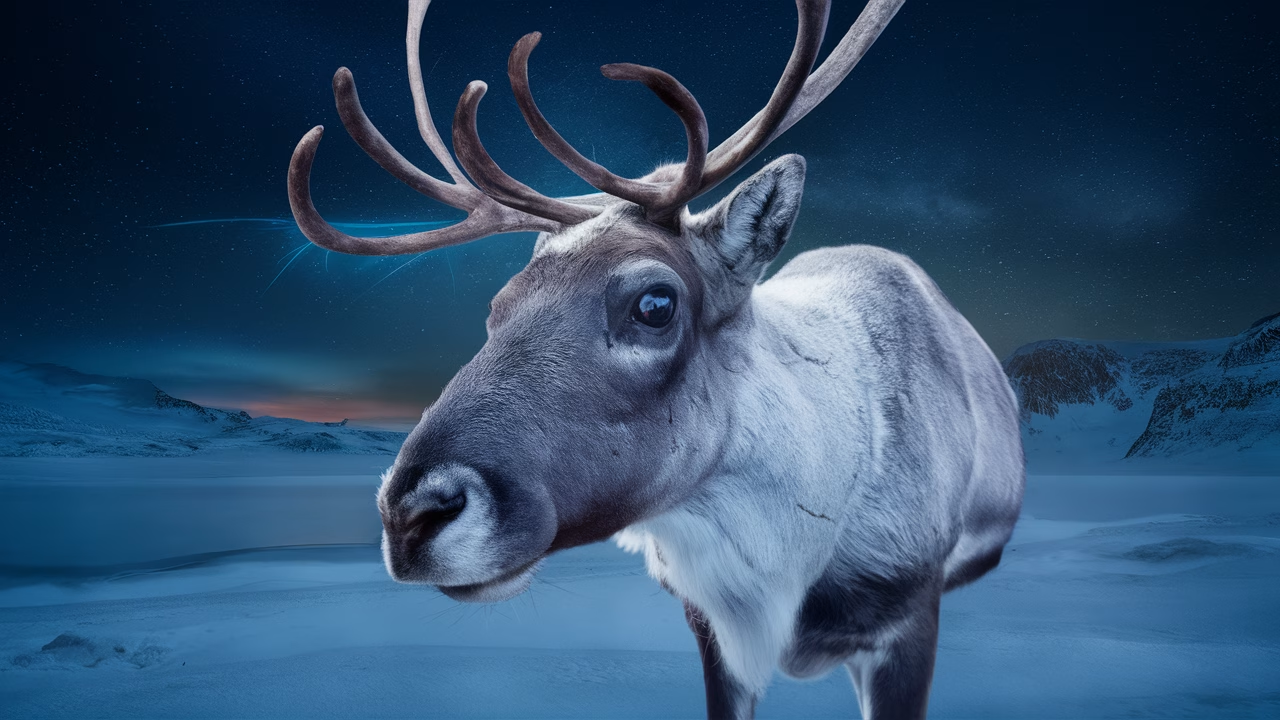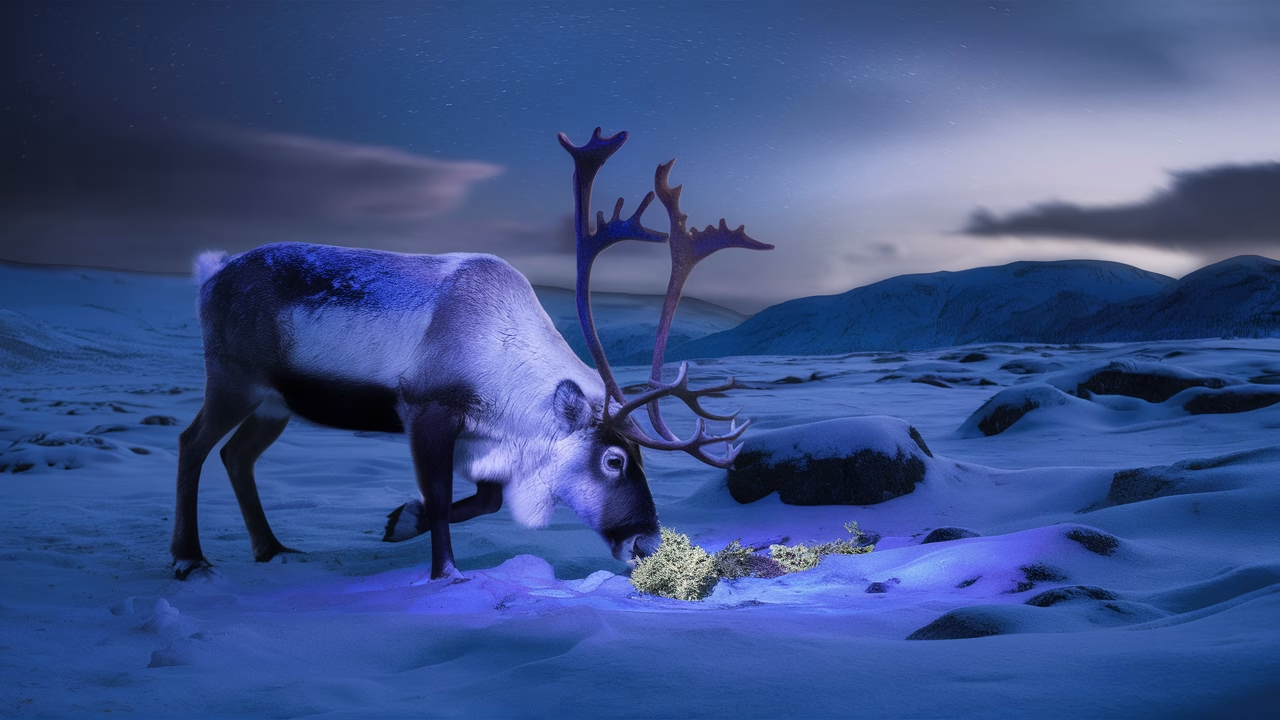How do reindeer see in the dark?
Arctic reindeer have evolved an extraordinary visual system that allows them to see ultraviolet (UV) light—a capability rare among mammals. This remarkable adaptation helps them navigate and find food during the dark Arctic winter, when sunlight is minimal and traditional vision would fall short. Understanding reindeer vision reveals one of nature’s most ingenious solutions to extreme environmental challenges.
TL;DR: The Reindeer’s Secret Edge in the Arctic Night
- Reindeer vision includes the ability to detect ultraviolet light, crucial for survival during the dark Arctic winter.
- This UV perception helps reindeer find food like lichen beneath the snow by seeing contrast invisible to humans or other ungulates.
- Special adaptations in their eyes, including seasonal changes in the tapetum lucidum and UV-transmitting corneas, support this unique visual capability.
- Their vision offers vital clues for understanding Arctic wildlife adaptation and supports conservation efforts in harsh environments.
The Science Behind Ultraviolet Light Perception
Understanding a Hidden Light Spectrum
Ultraviolet light sits just beyond the violet end of the visible light spectrum. While invisible to humans, some animals can perceive this spectrum—bees, certain birds, and remarkably, Arctic reindeer. What makes this so intriguing is that reindeer are among the very few terrestrial mammals with ultraviolet light perception. But why would these ungulates—typically seen as grazers—need such specialized vision? The answer lies in their harsh Arctic environment and the need to find food during months of darkness.
Biological Mechanisms Behind UV Visibility
Most mammalian lenses filter out UV light to prevent retinal damage. However, reindeer vision works differently—their cornea and lens allow ultraviolet light (wavelengths < 320 nm) to reach the retina. Scientific tests have shown that Arctic reindeer retinas respond to UV stimuli, particularly in the 330–320 nm range.
Additionally, reindeer possess a specialized reflective layer in their eyes called the tapetum lucidum. During summer, it reflects blue light, but in the dark Arctic winter, it transforms to a deep gold color, scattering light across the retina and dramatically increasing sensitivity in low-light conditions. These seasonal changes further enhance their ability to find food and navigate when other ungulates would struggle.
Adaptations of Reindeer Eyes in the Arctic Winter
Seasonal Shapeshifters of Ocular Design
Arctic reindeer eyes undergo structural changes that few mammals can match. During the dark Arctic winter, prolonged pupil dilation alters intraocular pressure and eventually compresses collagen in the tapetum lucidum. This compression deepens the tapetum’s color, shifting optimal wavelength reflection and enhancing low-light sensitivity—essentially providing natural night-vision upgrades that help these ungulates survive harsh conditions.
In practical terms, this means that Arctic reindeer don’t just see better in the dark—they see differently. Their world during the polar night isn’t pitch black. Instead, it’s painted in high-contrast UV nuances invisible to predators and other Arctic wildlife alike.
How Reindeer Use UV Vision to Find Food
Seeing What Others Can’t in a Snowy Landscape
One of the greatest challenges facing Arctic wildlife is locating edible vegetation beneath snow and ice. This is where reindeer vision truly shines. Their ultraviolet light perception allows them to distinguish lichen—particularly reindeer moss, a crucial winter staple—against UV-absorbent snow. Where humans and other ungulates see a monochrome whiteout, Arctic reindeer view what could be described as a UV-lit treasure map guiding them to essential nutrition.
Moreover, animal droppings, urine, and fur—indicators of other creatures’ presence—also reflect or absorb ultraviolet light distinctly. This means UV perception provides added advantages in tracking movement and detecting predators or herd members during the dark Arctic winter when survival depends on these critical visual cues.
Implications for Wildlife Conservation
Understanding to Safeguard the Arctic’s Most Visual Survivors
This remarkable adaptation represents more than just zoological curiosity. Reindeer vision serves as an evolutionary model illustrating how Arctic wildlife has adapted to one of Earth’s most extreme environments. Our growing understanding of such unique traits can significantly inform conservation strategies for these specialized ungulates.
For example, artificial lighting—particularly blue and UV light in thawing Arctic regions—could interfere with how reindeer navigate and find food. Recognizing the importance of ultraviolet light perception may help shape policies around light pollution and development in tundra habitats where these Arctic wildlife species depend on their specialized vision.
Beyond navigation, understanding how UV capabilities support predator detection reminds us of the delicate balance needed between predator and prey conservation. Protecting Arctic reindeer isn’t just about maintaining population numbers; it’s about preserving the sensory ecology that underpins their entire survival model during the challenging dark Arctic winter.
Final Thoughts
Arctic reindeer aren’t just rugged polar wanderers—they’re evolutionary innovators with remarkable visual adaptations. Their extraordinary ability to detect ultraviolet light has allowed these ungulates to carve out an ecological niche that most mammals couldn’t survive. These adaptations remind us that nature’s survival toolkit is far more varied and inventive than we often appreciate.
Understanding reindeer vision isn’t just scientifically fascinating—it’s essential for effective Arctic wildlife conservation. It reminds us that what seems invisible to us might be vividly obvious to creatures whose survival depends on seeing, not just enduring, the dark Arctic winter. As we work to protect these remarkable animals, we must remember that preserving their ability to find food and navigate using ultraviolet light perception is just as crucial as protecting their habitat.
Frequently Asked Questions
- Can reindeer really see ultraviolet light?
- Yes, reindeer detect ultraviolet wavelengths, which helps them survive and find food in low-light Arctic environments.
- How do reindeer benefit from UV vision?
- UV vision helps them see lichen against snow, detect predators, and navigate better during the dark Arctic winter.
- Is UV light harmful to reindeer eyes?
- Unlike humans, reindeer have adapted to allow safe UV detection—special corneas and retinas manage potential damage.
- Why don’t most mammals see UV light?
- Most mammals filter out UV to avoid retinal damage. Reindeer adapted due to specific survival needs in Arctic environments.
- Do any other animals in the Arctic see UV light?
- Some birds and insects do, but among large mammals, reindeer are quite unique in their ability to perceive UV.
- Does snow reflect UV light strongly?
- Yes, snow reflects UV light quite effectively, which is why UV perception is especially helpful in an Arctic landscape.
- Are deer or moose able to see UV like reindeer?
- There is limited evidence for UV sensitivity in other ungulates, but none match the level of UV adaptation seen in reindeer.





